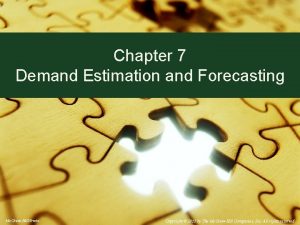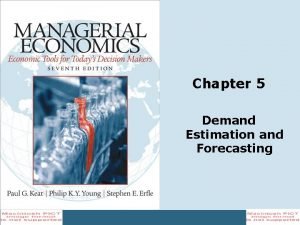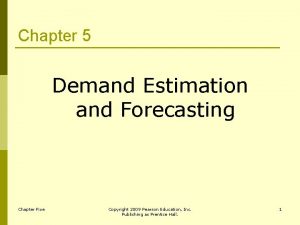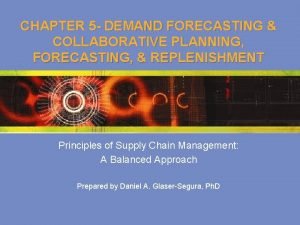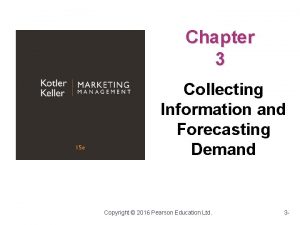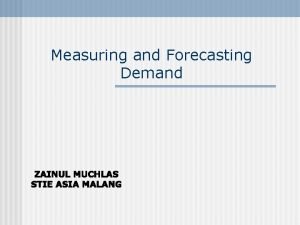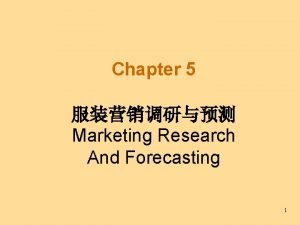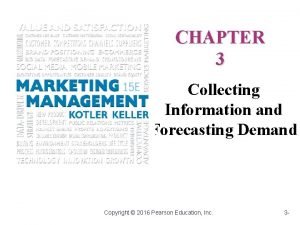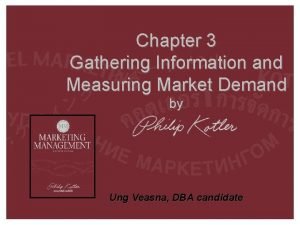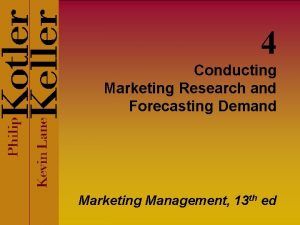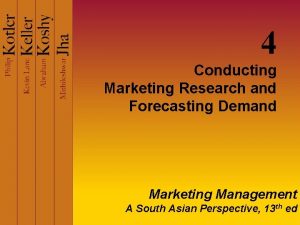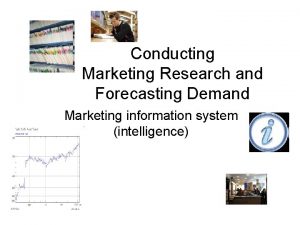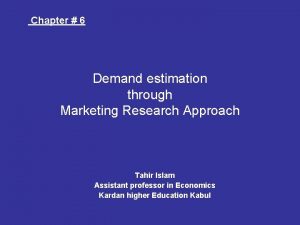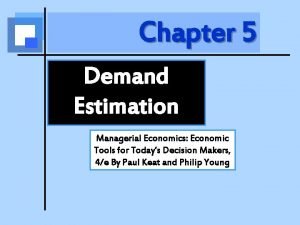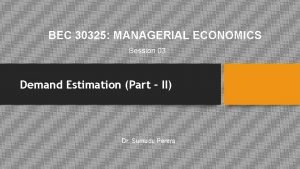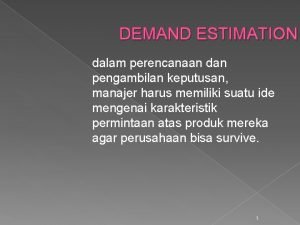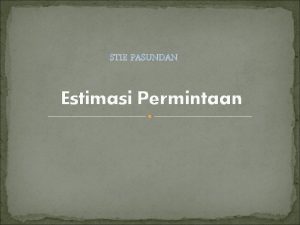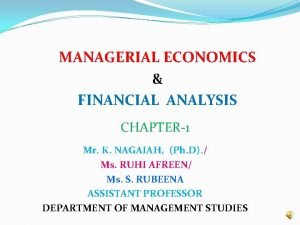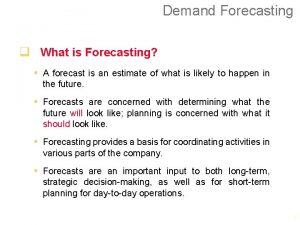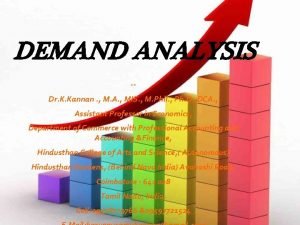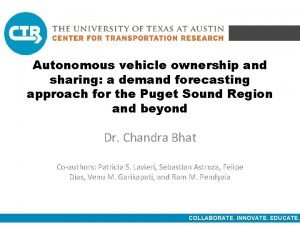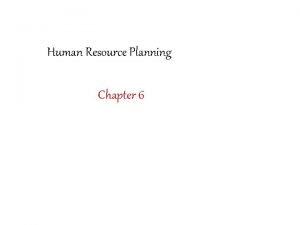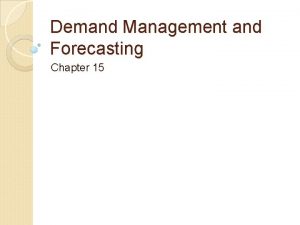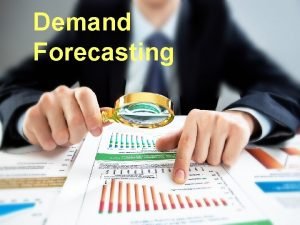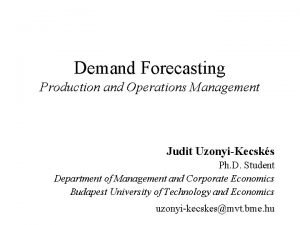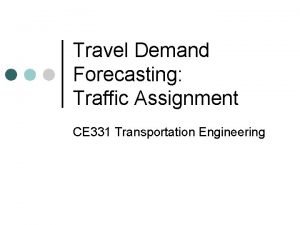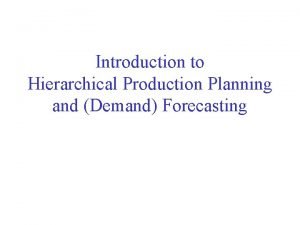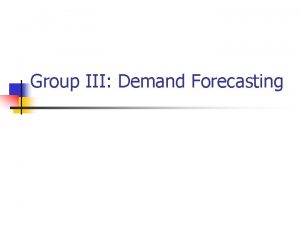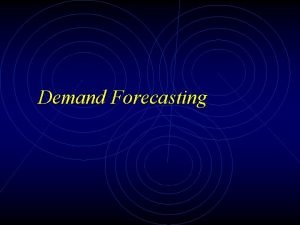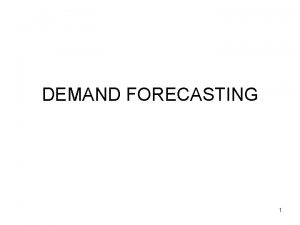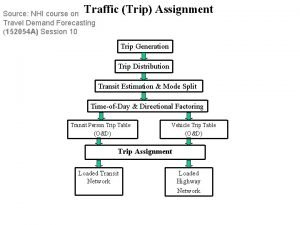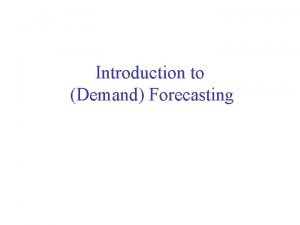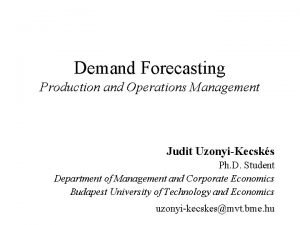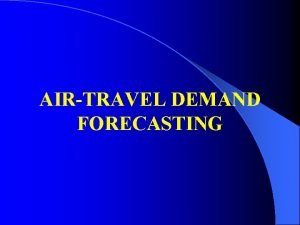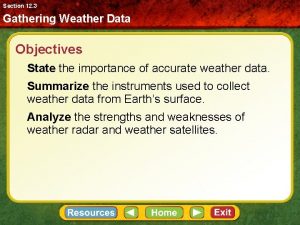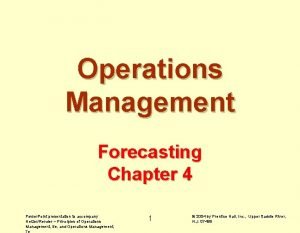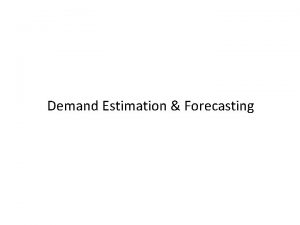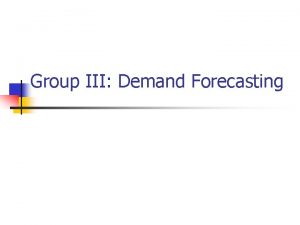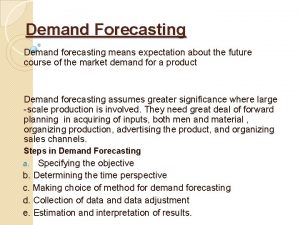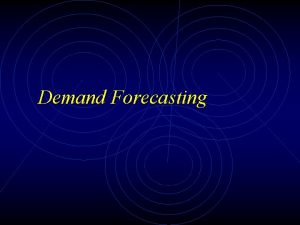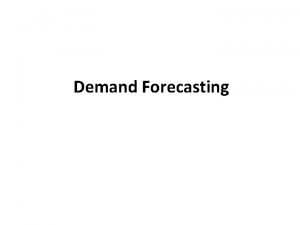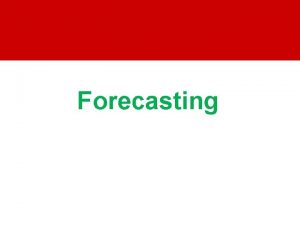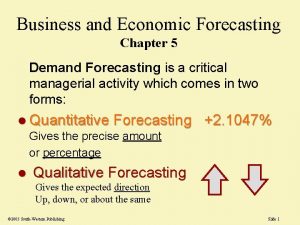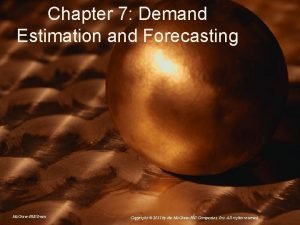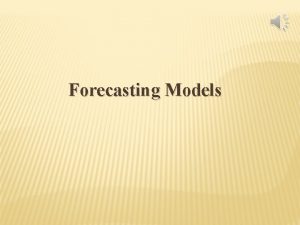Chapter 5 Demand Estimation and Forecasting Chapter Outline




















































- Slides: 52

Chapter 5 Demand Estimation and Forecasting

Chapter Outline • • • Regression analysis Limitation of regression analysis The importance of business forecasting Prerequisites of a good forecast Forecasting techniques Copyright © 2014 Pearson Education, Inc. All rights reserved. 5 -2

Learning Objectives • Understand the importance of forecasting in business • Know how to specify and interpret a regression model • Describe the major forecasting techniques used in business and their limitations • Explain basic smoothing methods of forecasting, such as the moving average and exponential smoothing Copyright © 2014 Pearson Education, Inc. All rights reserved. 5 -3

Data Collection • Statistical analyses are only as good as the accuracy and appropriateness of the sample of information that is used. • Several sources of data for business analysis: – buy from data providers (e. g. ACNielsen, IRI) – perform a consumer survey – focus groups – technology: point-of-sale data sources Copyright © 2014 Pearson Education, Inc. All rights reserved. 5 -4

Regression Analysis • Regression analysis: a procedure commonly used by economists to estimate consumer demand with available data Two types of regression: – cross-sectional: analyze several variables for a single period of time – time series data: analyze a single variable over multiple periods of time Copyright © 2014 Pearson Education, Inc. All rights reserved. 5 -5

Regression Analysis • Regression equation: linear, additive eg: Y: a: Xn : bn : Y = a + b 1 X 1 + b 2 X 2 + b 3 X 3 + b 4 X 4 dependent variable constant value, y-intercept independent variables, used to explain Y regression coefficients (measure impact of independent variables) Copyright © 2014 Pearson Education, Inc. All rights reserved. 5 -6

Regression Analysis • Interpreting the regression results: Coefficients: – negative coefficient shows that as the independent variable (Xn) changes, the variable (Y) changes in the opposite direction – positive coefficient shows that as the independent variable (Xn) changes, the dependent variable (Y) changes in the same direction – The regression coefficients are used to compute the elasticity for each variable Copyright © 2014 Pearson Education, Inc. All rights reserved. 5 -7

Regression Analysis • Statistical evaluation of regression results: – t-test: test of statistical significance of each estimated coefficient (whether the coefficient is significantly different from zero) b = Seb = coefficient estimated coefficient standard error of estimated Copyright © 2014 Pearson Education, Inc. All rights reserved. 5 -8

Regression Analysis • Statistical evaluation of regression results: – ‘rule of 2’: if absolute value of t is greater than 2, estimated coefficient is significant at the 5% level (for large samples-for small samples, need to use a t table) – if coefficient passes t-test, the variable has a significant impact on demand Copyright © 2014 Pearson Education, Inc. All rights reserved. 5 -9

Regression Analysis • Statistical evaluation of regression results – R 2 (coefficient of determination): percentage of variation in the variable (Y) accounted for by variation in all explanatory variables (Xn) R 2 value ranges from 0. 0 to 1. 0 The closer to 1. 0, the greater the explanatory power of the regression. Copyright © 2014 Pearson Education, Inc. All rights reserved. 5 -10

Regression Analysis • Statistical evaluation of regression results – F-test: measures statistical significance of the entire regression as a whole (not each coefficient) Copyright © 2014 Pearson Education, Inc. All rights reserved. 5 -11

Regression Analysis • Steps for analyzing regression results – check coefficient signs and magnitudes – compute elasticity coefficient – determine statistical significance Copyright © 2014 Pearson Education, Inc. All rights reserved. 5 -12

Regression Analysis • Textbook example: Management lessons from estimating demand for pizza – demand for pizza affected by 1. price of pizza 2. price of complement (soda) – managers can expect price decreases to lead to lower revenue – tuition and location are not significant Copyright © 2014 Pearson Education, Inc. All rights reserved. 5 -13

Regression Analysis • Challenges – Identification – Multicollinearity – Autocorrelation Copyright © 2014 Pearson Education, Inc. All rights reserved. 5 -14

Regression Analysis • Challenge 1: Identification problem: – The estimation of demand may produce biased results due to simultaneous shifting of supply and demand curves. – Solution: use of advanced correction techniques, such as two-stage least squares and indirect least squares may compensate for the bias Copyright © 2014 Pearson Education, Inc. All rights reserved. 5 -15

Regression Analysis • Challenge 2: Multicollinearity problem – Two or more independent variables are highly correlated, thus it is difficult to separate the effect each has on the dependent variable. – Solution: a standard remedy is to drop one of the closely related independent variables from the regression Copyright © 2014 Pearson Education, Inc. All rights reserved. 5 -16

Regression Analysis • Challenge 3: Autocorrelation problem – Also known as serial correlation, occurs when the dependent variable relates to the Y variable according to a certain pattern – Note: possible causes include omitted variables, or non-linearity; Durbin-Watson statistic is used to identify autocorrelation – Solution: to correct autocorrelation consider transforming the data into a different order of magnitude or introducing leading or lagging data Copyright © 2014 Pearson Education, Inc. All rights reserved. 5 -17

Forecasting • “Forecasting is very difficult, especially into the future. ” • Common subjects of business forecasts: – gross domestic product (GDP) – components of GDP • examples: consumption expenditure, producer durable equipment expenditure, residential construction – industry forecasts • example: sales of products across an industry – sales of a specific product Copyright © 2014 Pearson Education, Inc. All rights reserved. 5 -18

Forecasting • A good forecast should: – be consistent with other parts of the business – be based on knowledge of the relevant past – consider the economic and political environment as well as changes – be timely Copyright © 2014 Pearson Education, Inc. All rights reserved. 5 -19

Forecasting Techniques • Factors in choosing the right forecasting technique: – item to be forecast – interaction of the situation with the forecasting methodology--the value and costs – amount of historical data available – time allowed to prepare forecast Copyright © 2014 Pearson Education, Inc. All rights reserved. 5 -20

Forecasting Techniques • Six forecasting techniques – expert opinion – opinion polls and market research – surveys of spending plans – economic indicators – projections – econometric models Copyright © 2014 Pearson Education, Inc. All rights reserved. 5 -21

Forecasting Techniques • Approaches to forecasting – qualitative forecasting is based on judgments expressed by individuals or group – quantitative forecasting utilizes significant amounts of data and equations Copyright © 2014 Pearson Education, Inc. All rights reserved. 5 -22

Forecasting Techniques • Approaches to quantitative forecasting: – naïve forecasting projects past data without explaining future trends – causal (or explanatory) forecasting attempts to explain the functional relationships between the dependent variable and the independent variables Copyright © 2014 Pearson Education, Inc. All rights reserved. 5 -23

Forecasting Techniques • Expert opinion techniques – Jury of executive opinion: forecasts generated by a group of corporate executives assembled together Copyright © 2014 Pearson Education, Inc. All rights reserved. 5 -24

Forecasting Techniques • Expert opinion techniques – The Delphi method: a form of expert opinion forecasting that uses a series of questions and answers to obtain a consensus forecast, where experts do not meet Copyright © 2014 Pearson Education, Inc. All rights reserved. 5 -25

Forecasting Techniques • Opinion polls: sample populations are surveyed to determine consumption trends – may identify changes in trends – choice of sample is important – questions must be simple and clear Copyright © 2014 Pearson Education, Inc. All rights reserved. 5 -26

Forecasting Techniques • Market research: is closely related to opinion polling and will indicate not only why the consumer is (or is not) buying, but also – who the consumer is – how he or she is using the product – characteristics the consumer thinks are most important in the purchasing decision Copyright © 2014 Pearson Education, Inc. All rights reserved. 5 -27

Forecasting Techniques • Surveys of spending plans: yields information about ‘macro-type’ data relating to the economy, especially: – consumer intentions • examples: Survey of Consumers (University of Michigan), Consumer Confidence Survey (Conference Board) – inventories and sales expectations Copyright © 2014 Pearson Education, Inc. All rights reserved. 5 -28

Forecasting Techniques • Economic indicators: a barometric method of forecasting designed to alert business to changes in conditions – leading, coincident, and lagging indicators – composite index: one indicator alone may not be very reliable, but a mix of leading indicators may be effective Copyright © 2014 Pearson Education, Inc. All rights reserved. 5 -29

Forecasting Techniques • Leading indicators predict future economic activity – average hours, manufacturing – initial claims for unemployment insurance – manufacturers’ new orders for consumer goods and materials – vendor performance, slower deliveries diffusion index – manufacturers’ new orders, nondefense capital goods Copyright © 2014 Pearson Education, Inc. All rights reserved. 5 -30

Forecasting Techniques • Additional leading indicators to predict future economic activity – building permits, new private housing units – stock prices, 500 common stocks – money supply, M 2 – interest rate spread, 10 -year Treasury bonds minus federal funds – index of consumer expectations Copyright © 2014 Pearson Education, Inc. All rights reserved. 5 -31

Forecasting Techniques • Coincident indicators identify trends in current economic activity – employees on nonagricultural payrolls – personal income less transfer payments – industrial production – manufacturing and trade sales Copyright © 2014 Pearson Education, Inc. All rights reserved. 5 -32

Forecasting Techniques • Lagging indicators confirm swings in past economic activity – average duration of unemployment, weeks – ratio, manufacturing and trade inventories to sales – change in labor cost per unit of output, manufacturing (%) Copyright © 2014 Pearson Education, Inc. All rights reserved. 5 -33

Forecasting Techniques • Additional lagging indicators confirm swings in past economic activity – average prime rate charged by banks – commercial and industrial loans outstanding – ratio, consumer installment credit outstanding to personal income – change in consumer price index for services Copyright © 2014 Pearson Education, Inc. All rights reserved. 5 -34

Forecasting Techniques • Economic indicators: drawbacks – leading indicator index has forecast a recession when none ensued – a change in the index does not indicate the precise size of the decline or increase – the data are subject to revision in the ensuing months Copyright © 2014 Pearson Education, Inc. All rights reserved. 5 -35

Forecasting Techniques • Trend projections: a form of naïve forecasting that projects trends from past data without taking into consideration reasons for the change – compound growth rate – visual time series projections – least squares time series projection Copyright © 2014 Pearson Education, Inc. All rights reserved. 5 -36

Forecasting Techniques • Compound growth rate: forecasting by projecting the average growth rate of the past into the future – provides a relatively simple and timely forecast – appropriate when the variable to be predicted increases at a constant percentage Copyright © 2014 Pearson Education, Inc. All rights reserved. 5 -37

Forecasting Techniques • General compound growth rate formula: E/B = (1+i)n E n B i = = final value years in the series beginning value constant growth rate Copyright © 2014 Pearson Education, Inc. All rights reserved. 5 -38

Forecasting Techniques • Visual time series projections: plotting observations on a graph and viewing the shape of the data and any trends Copyright © 2014 Pearson Education, Inc. All rights reserved. 5 -39

Forecasting Techniques • An Example in Which the Constant Compound Growth Rate Approach Would Be Misleading Copyright © 2014 Pearson Education, Inc. All rights reserved. 5 -40

Forecasting Techniques • Time series analysis: a naïve method of forecasting from past data by using least squares statistical methods to identify trends, cycles, seasonality, and irregular movements Copyright © 2014 Pearson Education, Inc. All rights reserved. 5 -41

Forecasting Techniques • Time series analysis: – easy to calculate – does not require much judgment or analytical skill – describes the best possible fit for past data – usually reasonably reliable in the short run Copyright © 2014 Pearson Education, Inc. All rights reserved. 5 -42

Forecasting Techniques • Time series data can be represented as: Yt = f(Tt, Ct, St, Rt) Yt Tt Ct St Rt = = = actual value of the data at time t trend component at t cyclical component at t seasonal component at t random component at t Copyright © 2014 Pearson Education, Inc. All rights reserved. 5 -43

Forecasting Techniques • Time series components: seasonality – need to identify and remove seasonal factors, using moving averages to isolate those factors – remove seasonality by dividing data by seasonal factor Copyright © 2014 Pearson Education, Inc. All rights reserved. 5 -44

Forecasting Techniques • Time series components: trend – to remove trend line, use least squares method – possible best-fit line styles: straight line: exponential line: quadratic line: Y = a + b(t) Y = abt Y = a + b(t) + c(t)2 – choose one with best R 2 Copyright © 2014 Pearson Education, Inc. All rights reserved. 5 -45

Forecasting Techniques • Time series components: cyclical, random – isolate cyclical components by smoothing with a moving average – random factors cannot be predicted and should be ignored Copyright © 2014 Pearson Education, Inc. All rights reserved. 5 -46

Forecasting Techniques • Smoothing techniques – Moving average • The larger the number of observations in the average, the greater the smoothing effect. – Exponential smoothing • Allows for the decreasing importance of information in the more distant past. Copyright © 2014 Pearson Education, Inc. All rights reserved. 5 -47

Forecasting Techniques • Moving average: average of actual past results used to forecast one period ahead Et+1 Xt, Xt-1 N average = = (Xt + Xt-1 + … + Xt-N+1)/N forecast for next period actual values at their respective times number of observations included in Copyright © 2014 Pearson Education, Inc. All rights reserved. 5 -48

Forecasting Techniques • Exponential smoothing: allows for decreasing importance of information in the more distant past, through geometric progression Et+1 = w·Xt + (1 -w) · Et w = weight assigned to an actual observation at period t Copyright © 2014 Pearson Education, Inc. All rights reserved. 5 -49

Forecasting Techniques • Econometric models: causal or explanatory models of forecasting – regression analysis – multiple equation systems • endogenous variables: dependent variables that may influence other dependent variables • exogenous variables: from outside the system, truly independent variables Copyright © 2014 Pearson Education, Inc. All rights reserved. 5 -50

Forecasting Techniques • Illustration of a model of the relationship between the domestic currency and a foreign currency: Et = a + b. It + c. Rt + d. Gt – where E = Exchange rate of a foreign currency in terms of the domestic currency – I = Domestic inflation rate minus foreign inflation rate – R = Domestic nominal interest rate minus foreign nominal interest rate – G = Domestic growth rate of GDP minus the growth rate of foreign GDP – t = Time period – a, b, c, d Regression coefficients Copyright © 2014 Pearson Education, Inc. All rights reserved. 5 -51

Summary • Regression analysis is a primary tool used by businesses to understand demand. • Reliable input data and proper estimation and evaluation are needed. • Forecasting is an important activity in many organizations. In business, forecasting is a necessity. • This chapter summarized and discussed six of the major forecasting techniques used by businesses. Copyright © 2014 Pearson Education, Inc. All rights reserved. 5 -52
 What is demand estimation
What is demand estimation Demand estimation and forecasting
Demand estimation and forecasting Demand estimation and forecasting
Demand estimation and forecasting Demand estimation and forecasting
Demand estimation and forecasting Associative forecasting
Associative forecasting Forecasting and demand measurement
Forecasting and demand measurement Demand measurement in marketing
Demand measurement in marketing Capturing marketing insights examples
Capturing marketing insights examples Forecasting and demand measurement in marketing
Forecasting and demand measurement in marketing Collecting information and forecasting demand
Collecting information and forecasting demand Demand measurement in marketing
Demand measurement in marketing Marketing research and forecasting demand
Marketing research and forecasting demand Conducting marketing research and forecasting demand
Conducting marketing research and forecasting demand Collecting information and forecasting demand summary
Collecting information and forecasting demand summary Q=nqp
Q=nqp Marketing research approaches to demand estimation
Marketing research approaches to demand estimation What is demand estimation in managerial economics
What is demand estimation in managerial economics Demand estimation in managerial economics
Demand estimation in managerial economics Demand estimation
Demand estimation Estimasi fungsi permintaan
Estimasi fungsi permintaan Module 5 supply and demand introduction and demand
Module 5 supply and demand introduction and demand Hotel demand forecasting
Hotel demand forecasting Statistical methods of demand forecasting
Statistical methods of demand forecasting Chain ratio method demand forecasting examples
Chain ratio method demand forecasting examples Types of forecasting
Types of forecasting Statistical methods of demand forecasting
Statistical methods of demand forecasting Forecasting demand for autonomous vehicles
Forecasting demand for autonomous vehicles Factors affecting hr demand forecasting
Factors affecting hr demand forecasting Demand forecasting objectives
Demand forecasting objectives Micro level demand forecasting
Micro level demand forecasting Demand forecasting in operations management
Demand forecasting in operations management Dynamic traffic assignment
Dynamic traffic assignment Hierarchical production planning
Hierarchical production planning Demand forecasting objectives
Demand forecasting objectives Limitations of demand forecasting
Limitations of demand forecasting Simultaneous equation method in demand forecasting
Simultaneous equation method in demand forecasting Demand forecasting
Demand forecasting Chain ratio method of demand forecasting
Chain ratio method of demand forecasting Demand forecasting introduction
Demand forecasting introduction Tracking signal
Tracking signal Air travel demand forecasting
Air travel demand forecasting Deficient demand and excess demand
Deficient demand and excess demand Dependent vs independent demand
Dependent vs independent demand Ang demand function
Ang demand function Distinguish between individual demand and market demand
Distinguish between individual demand and market demand Independent demand and dependent demand
Independent demand and dependent demand Sandwich paragraph example
Sandwich paragraph example Deterministic and stochastic inventory models
Deterministic and stochastic inventory models Market demand curve
Market demand curve Independent demand inventory examples
Independent demand inventory examples Compare and contrast analog and digital forecasting
Compare and contrast analog and digital forecasting Compare and contrast analog and digital forecasting
Compare and contrast analog and digital forecasting Operations management chapter 4 forecasting solutions
Operations management chapter 4 forecasting solutions

